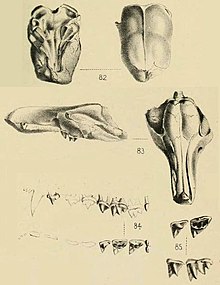Proviverrinae
| Proviverrinae Temporal range: Early to Late Eocene | |
|---|---|

| |
| Fossil of Lesmesodon edingeri | |

| |
| Skull of Proviverra typica | |
| Scientific classification | |
| Domain: | Eukaryota |
| Kingdom: | Animalia |
| Phylum: | Chordata |
| Class: | Mammalia |
| Order: | †Hyaenodonta |
| Superfamily: | †Hyaenodontoidea |
| Subfamily: | †Proviverrinae Schlosser, 1886[1] |
| Type genus | |
| †Proviverra Rütimeyer, 1862 | |
| Genera | |
| |
| Synonyms | |
Proviverrinae ("before civets") is an extinct subfamily of placental mammals within the extinct order Hyaenodonta. Fossil remains of these mammals are known from early to late Eocene deposits in Europe.[6][7][8]
Classification and phylogeny
Taxonomy
- Subamily: †Proviverrinae (Wortman, 1902)
- Genus: †Minimovellentodon (Solé, 2014)
- †Minimovellentodon russelli (Solé, 2014)
- Genus: †Morlodon (Solé, 2013)
- †Morlodon vellerei (Solé, 2013)
- Genus: †Parvagula (Lange-Badré, 1987)
- †Parvagula palulae (Lange-Badré, 1987)
- Genus: †Allopterodon (Ginsburg, 1977)
- †Allopterodon bulbosus (Lange-Badré, 1979)
- †Allopterodon minor (Filhol, 1877)
- †Allopterodon torvidus (Van Valen, 1965)
- Genus: †Lesmesodon (Morlo & Habersetzer, 1999)
- †Lesmesodon behnkeae (Morlo & Habersetzer, 1999)
- †Lesmesodon edingeri (Springhorn, 1982)
- †Lesmesodon gunnelli (Solé, 2021)
- Genus: †Proviverra (Rütimeyer, 1862)
- †Proviverra typica (Rütimeyer, 1862)
- Genus: †Minimovellentodon (Solé, 2014)
References
- ^ Schlosser, M. (1886.) "Paläontologische Notizen. Über das Verhältnis der Cope’schen Creodonta zu den übrigen Fleischfressern." Archived 10 July 2022 at the Wayback Machine Morphologische Jahrbuch 12: 287–294.
- ^ Haeckel, Ernst (1895). Systematische Phylogenie: Wirbelthiere (in German). Vol. T.3. Berlin: G. Reimer.
- ^ W. D. Matthew (1909.) "The Carnivora and Insectivora of the Bridger Basin, middle Eocene." Archived 6 July 2022 at the Wayback Machine Memoirs of the American Museum of Natural History 9:289–567
- ^ Van Valen, Leigh (1965). "Some European Proviverrini (Mammalia, Deltatheridia)" (PDF). Palaeontology. 8: 638–665. Archived (PDF) from the original on 2 April 2022. Retrieved 15 August 2022.
- ^ Trouessart, E. L. (1885.) "Note sur le classification des Analgésiens et diagnoses d'espèces et de genres nouveaux." Archived 8 July 2022 at the Wayback Machine Bulletin de la Société d'études scientifiques d'Angers, 14, 46–89. [Publ. February 1885. for year 1884.]
- ^ McKenna, Malcolm C.; Bell, Susan K. (1997). Classification of Mammals Above the Species Level. New York: Columbia University Press. ISBN 978-0-231-11012-9. Archived from the original on 10 May 2024. Retrieved 16 March 2015.
- ^ Floréal Solé (2013). "New proviverrine genus from the Early Eocene of Europe and the first phylogeny of Late Palaeocene–Middle Eocene hyaenodontidans (Mammalia)". Journal of Systematic Palaeontology. 11 (4): 375–398. Bibcode:2013JSPal..11..375S. doi:10.1080/14772019.2012.686927. S2CID 84734979.
- ^ Floréal Solé; Jocelyn Falconnet; Laurent Yves (2014). "New proviverrines (Hyaenodontida) from the early Eocene of Europe; phylogeny and ecological evolution of the Proviverrinae". Zoological Journal of the Linnean Society. 171 (4): 878–917. doi:10.1111/zoj.12155.
